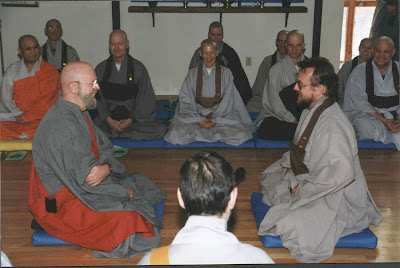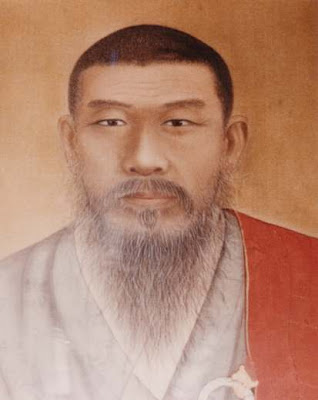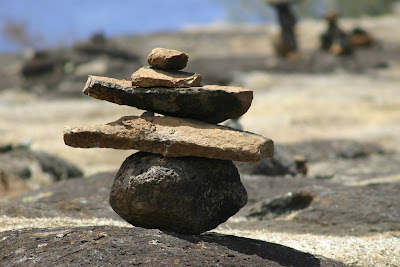
One of the core tenants of many Zen Buddhist Sects is Koan practice. The original concept of Koan, although associated with Buddhist practice in the West is not strictly a Buddhist term and translated means “a public case,” “a public exchange,” “a public situation,” or “a public document.” The pronunciation of the Chinese characters for Koan is Gong-àn in Chinese or Koan in Japanese. The common use for this word comes from ancient China, and referred to a situation when copies of a government document were produced, the scribe would use a “chop” or seal on the copy in such a way that half of the seal was on the original document and half was on the copied document. This would allow for future verification of the authenticity of the copy by matching the two halves of the seal.
In the Zen tradition, Koan has come to mean that the aspirant’s understanding of a question put forth in one of the ancient collections of Zen stories such as the Blue Cliff Record, is metaphorically one-half of the collective understanding (the copy’s seal;) and this matches the teacher’s understanding of that same question (the original’s seal), which is the other metaphorical half of the collective understanding. When the aspirant and teacher share the same understanding it is called a mind-to-mind connection.
Then to practice Koans correctly, means to ponder over the ancient Zen exchanges between Zen teachers and their students. By understanding the Koan’s essential point at the moment of attainment, means that the aspirant’s Koan insight has come to fruition. In the ancient days of Zen practice in China there was no actual exchange called Koan practice between teacher and student; but eventually, a future Chán Ancestor named Nanyue Huáiràng, came to visit Dàjing Huìnéng, the sixth Chán Ancestor of Zen Buddhism and their historical conversation became the root of what we now understand as Zen Koan practice. In this conversation Huìnéng asked Huáiràng, “Where do you come from?” Huáiràng replied that he came from Sung Shan (Sung Mountain). Huìnéng asked again, “What is this thing that has come here?” Huáiràng tried but could not answer. This became the first systematic use of a Koan in the Chinese Zen tradition and the seemingly imponderable “what is this?” became the big question for Huáiràng. It took him more than eight years to eventually understand the full meaning of Huìnéng’s question.
Consequently, future generations of Zen teachers began to see the efficacy of asking their student’s such imponderable questions and started to peruse the ancient Buddhist literature for evidence of situations in history which could become the basis of reflection by future Zen students. A few examples that were discovered in Sutras and Shastras are as follows: Buddha sat under the Bodhi tree for seven years entertaining a big question: what is life, and what is death? Also, many years after the last Indian Ancestor of Buddhism named Bodhidharma had arrived in China, Dazu Huìke, who was to become the first Chinese Chán Ancestor, sought to study with the enigmatic teacher. Bodhidharma had settled in a cave on Sung Mountain in central China and had been meditating for nine years by just staring at the wall. At first Bodhidharma refused to even acknowledge Huìke’s presence. But Huìke was earnest and tried many things to get the teachers attention, eventually, out of desperation and to show that he was sincere in his quest, he cut off his arm and presented it to Bodhidharma.
Upon seeing this, Bodhidharma asked him, “What do you want?” Huìke said, “My mind is not at ease. Please pacify my mind.” Bodhidharma said, “Bring me your mind and I will pacify it.” Huìke didn’t understand and so replied: “When I look for my mind I cannot find it.” “There,” said Bodhidharma, “I have pacified it for you.” At this, Huìke attained enlightenment; consequently, this question, “What is mind?,” has become an inspiration for Zen students for more than fifteen hundred years.
Many other questions came out of the ancient stories. Notably some of those questions were, what is this, what is life, what is death, and lastly what is mind. All of these questions eventually became Koans and Zen teachers started to use these questions to tailor their own style of practice.
Koans are not special or magical in and of themselves; they have been developed as a method Zen Teachers use to teach students about the correct situation, the correct function, and the correct relationship of a given situation. Furthermore, they are used to teach students to function correctly in their everyday lives. However, occasionally an ancient Zen Masters’ response to a question was purposefully incorrect, in this case the teacher used the situation to teach correct function and correct direction to the student in the story. An example of this type of Koan would be Zhàozhou’s answer when asked by a monk whether a dog has Buddha-nature or not. His response of (“WU!” or “no”) is not correct, but he used the monk’s question to teach the monk about correct direction. Yet another example occurred while two monks were arguing over their perception as to whether a flag was moving or the breeze was moving. Master Huìnéng, the Sixth Chán Ancestor, who overheard this conversation, said to the two monks, “It is your mind that is moving.” Even though, Chán Master Huìnéng’s response is not precisely correct, he used this statement, "It is neither the wind nor the flag which moves it is your mind that is moving," in an effort to teach these two monks about correctly perceiving things as they are.
Still another example is found in the Lecture at Vulture Peak when Sakyamuni Buddha simply held up a single flower instead of delivering a lecture as he had done in the past. None of the twelve hundred monks gathered at the assembly understood the meaning of this simple action. Eventually, Mahàkàsyapa smiled. Then the Buddha said to Mahàkàsyapa, “I give to you my all–pervading true dharma, incomparable nirvana, exquisite teaching of formless form. Not dependent on words, a transmission outside the sutras, this I give to you.” This response from Buddha was also not correct, yet he said “my dharma I transmit to you” to illuminate the assembly about correct direction and point towards a correct livelihood.
This type of Koan practice is only one technique used to help Zen students to not be attached to correct answers or incorrect answers. Koans are used to perceive directly how to function correctly in everyday life. Furthermore, Koan practicing is only one of the techniques used in Zen. It is much like an analogy about different methods of eating. Americans eat using a knife and fork, Chinese people eat using chopsticks, Koreans like to use chopsticks and a spoon and Indians will use their hands; however, each of these groups end up with a full stomach regardless of which method they use to eat.
If the Zen aspirant is creating something special in his or her life, then that student will also have a problem understanding some aspect of Koan practic; so one use of Koan practice is to take away the student’s opinion. If the student can drop his or her opinion, it is then possible to manifest a mind that is clear like space. Furthermore, correct Zen practice shows up in the student’s ability to respond to each situation correctly and meticulously. It also means that the student must understand his or her correct job in this very moment. This means that moment–to–moment the correct relationship appears of itself. When Koan practice is correct, the moment–to–moment correct situation, correct function, and correct relationship will appear by itself.
If the student holds a Koan too tightly, or is attached to a Koan, or wants something from Koan practice, then he or she will end up with a big problem. Keeping one’s current Koan or “a don’t know mind,” moment after moment after moment without making anything, is by itself correct direction and correct life. The old-style Koans give the student a great gift in the form of a question like: What is life? What is death? What is mind? What is this moment?
Another aspect of Koan practice means keeping a great question along with having great faith and manifesting great courage. A great question means not holding on to intellectual–style thinking. An eminent teacher once said that, “Ten thousand questions are all one question.” This one question is distilled down to only don’t know which is no thinking at all. Each Koan is only a finger pointing to the moon. If the student is focusing on only the finger, then he or she don’t have a chance at perceiving the moon. Just remember that the most important thing is to keep a correct direction which is practicing “only don’t know.”
In Koan practice, there is no American mind, no old Chinese mind, no Korean mind, or not even Japanese mind, because correct Koan practicing keeps a before–thinking mind. Originally in the Golden Age of Zen, students would receive only one Koan from their teacher and practice for many years on this question. This original approach was to isolate yourself in some remote mountainous region, cut off completely from the outside world, and contemplate this one Koan while meditating, working, eating, sleeping, walking, sitting and lying down. Eventually, if the student’s aspiration was complete this question would lead the student to enlightenment.
Koan practice has transformed over the years and to achieve enlightenment or to not achieve enlightenment is no longer the goal. Koan practice is used to clarify the student’s direction, as well as helping in the student’s everyday life. Not attaching to a Koan is of paramount importance. Using Koans to function correctly will allow the student’s moment to moment mind to manifest clearly. It is important to relinquish everything: relinquish your opinion, relinquish your condition, and relinquish your situation by practicing constantly with a don’t know mind. This will allow a correct response to appear by itself. In the interview room hitting the floor or shouting KATZ is only a technique. Using these techniques are sometimes necessary, and sometimes they are not necessary, it is important for the student to perceive the situation correctly and the appropriate response will follow.
It can’t be overstated that approaching a Koan correctly is important and necessary. When a student doesn’t practice correctly, then the “I–my–me” mind appears, bringing with it competition and pride. If the student can correctly approach a Koan, then this kind of (analytical) thinking mind won’t appear. The student is required to throw away attachments to all conditions, opinions, and situations. It seems that most Zen students have a mind that is intellectual and very analytical which makes penetrating a Koan very difficult. Practicing correctly with Koans means to keep a mind that is very simple; and in simple mind, there is no “I–my–me.”
If the student’s everyday life is clear, then Koan practice is not necessary. Then Koan practice is no longer for us, it is then only used to teach students. Sometimes a senior student’s own life can be very clear, but they don’t understand how to teach newer students how to function correctly in their everyday lives. Also, these senior students don’t understand how to teach truth and correct way. But, when a student’s clear life, truth, and correct way come together in a meticulous way, then moment–to–moment, their life is manifest in a Koan. Only having a clear life is not enough to become an effective teacher. For example, eating only one kind of food all the time will result in having many physical and medical problems. The human body uses different kinds of food for a good balance, which results in a correct body.
There are four kinds of Koans which can be explained with a simple statement of “like this”. The first is “without like this.” “Without like this” means: true emptiness, primary point, silence and complete stillness. Examples of “without like this” Koans are: “What is true emptiness?” and “What is complete stillness?” The second type of Koan is “become one like this” which means to either shout KATZ!, or a demonstration of primary point or to hit the floor. An example of a “become one like this Koans” would be: “Buddha picked up a flower and Mahàkàsyapa smiled. What does this mean?” The third type of Koan is “only like this” which means the meaning is truth or the true function of primary point. Examples of this type of Koans are: “spring comes, grass grows by itself,” “3 x 3 = 9,” “what is Buddha,” or “three pounds of flax.” The fourth and last type is called “just like this,” this means just doing is correct life or one–point correct function. Examples of this type of Koans are: “go drink tea,” and “go wash your bowls.”
Understanding these four types of Koans in this way allows you freedom in your practicing. When the student enters the interview room; the teacher places a cup and a pen on the floor and asks if the cup and the pen are the same or different. The four kinds of “like this” answers could be:
· Without like this: maintain complete silence, a don’t know mind.
· Become one like this: hit the floor or shout KATZ!
· Only like this: saying “cup is cup, pen is pen.”
· Just like this: drink from the cup, write with the pen.
Labels: koans, zen





















